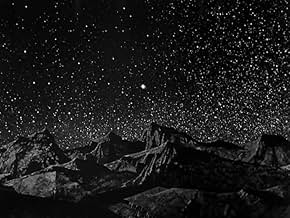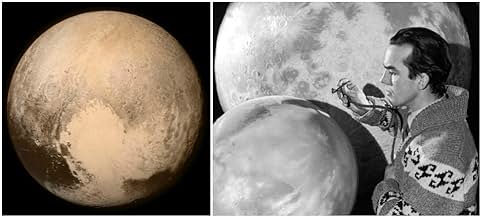Ajouter une intrigue dans votre langueA journey through the universe as it would appear to a space traveler beginning at the David Dunlap Observatory on Earth.A journey through the universe as it would appear to a space traveler beginning at the David Dunlap Observatory on Earth.A journey through the universe as it would appear to a space traveler beginning at the David Dunlap Observatory on Earth.
- Réalisation
- Scénario
- Casting principal
- Nommé pour 1 Oscar
- 2 victoires et 1 nomination au total
Douglas Rain
- Narrator
- (voix)
- (non crédité)
Avis à la une
Award-winning Canadian documentary that transports the viewer through space from the Sun and the inner planets of the solar system to the black emptiness of the intergalactic void. The imagery is striking and Douglas Rain's narration is interesting and evocative (sadly, the statement that the transient dark patches on Mars were vegetation turned out not to be the case). The film is framed with scenes of University of Toronto astronomer Dr. Donald MacRae preparing the 74" reflector telescope at The David Dunlap Observatory for a night of star photography and watching him manually set up and calibrate the massive pre-computer instrument is fascinating. 'Universe' may be best known as one of the inspirations for Stanley Kubrick's '2001 A Space Odyssey' (1968). Kubrick was so impressed that he recruited some of the production crew for his epic space opus and chose Rain to be the iconic voice of the renegade HAL9000 computer. Needless to say, the film's imagery cannot be compared with contemporary CGI space-art but if watched with 1960's eyes 'Universe' is an outstanding trip into the beyond.
This film was one of a series of films made by the CNFB. However, there is no doubt that it had a huge impact when it allowed Stanley Kubrick to imagine making 2001 A Space Odyssey. Largely uncredited are the special effects of Wally Gentleman who went to England to work with Kubrick on 2001. Also the other reviewers complaints about the narration are somewhat amusing since the voice is Douglas Rains, the same Canadian actor who was the voice of HAL 9000 and perhaps one of the most famous movie voices in history! Worth seeing and if you want to hear more of Rains check out the CNFB films on major religions of the world. Hear HAL 9000 talk about Buddhism!
10Inigo-3
When this black-and-white astronomy documentary came out in 1960, it was a startling venture into groundbreaking special effects--a grand tour of the universe from our own planet to the far-flung galactic clusters at the limits of mid-century astronomical observation. Although much of the information is now dated (particularly that on Mars and Venus), the film deserves video release if only for its consummate artistry in combining visuals, music, and narration. When he was assembling a crew for "2001--A Space Odyssey," Stanley Kubrick was so impressed with the film that he tried to hire the team that created it; unfortunately they were unavailable.
The National Film Board of Canada takes the audience on a journey from the David Dunlap Observatory in Richmond Hill in Ontario to the endless reaches of space.
Certainly, this documentary is dated, in terms of what we know nowadays - those of us who actually understand astrophysics, which includes few readers of this review, I am sure - what we can show on a screen, and what can be done with that information. Nowadays, NASA and other agencies can produce enormous detailed pictures of unimaginably distant objects, can figure out if there are planets the size of the earth circling distant stars, and can listen for broadcasts from alien intelligences. But can any of them produce such stark and beautiful black-and-white images, or read the intelligently written script with such awe as narrator Douglas Rain?
It is claimed that Stanley Kubrick based the visual effects of 2001:A SPACE ODYSSEY on this film, and chose Rain to voice Hal 9000 based on his erfirmance here.... after earlier choices were unavailable. I can believe it.
Certainly, this documentary is dated, in terms of what we know nowadays - those of us who actually understand astrophysics, which includes few readers of this review, I am sure - what we can show on a screen, and what can be done with that information. Nowadays, NASA and other agencies can produce enormous detailed pictures of unimaginably distant objects, can figure out if there are planets the size of the earth circling distant stars, and can listen for broadcasts from alien intelligences. But can any of them produce such stark and beautiful black-and-white images, or read the intelligently written script with such awe as narrator Douglas Rain?
It is claimed that Stanley Kubrick based the visual effects of 2001:A SPACE ODYSSEY on this film, and chose Rain to voice Hal 9000 based on his erfirmance here.... after earlier choices were unavailable. I can believe it.
This short, done under the auspices of the National Film Board of Canada, holds up quite well in an area that can date in an instant. The animation effects are exceptional and my only real problem was with the narrator who came perilously close to becoming a cure for insomnia. Very well done, it was nominated for an Oscar for Documentary Short. Recommended, with the caveat that later information renders some of this less useful on technical points.
Le saviez-vous
- Anecdotes'Stanley Kubrick' viewed this film and was used as a template for the special effect shots used in his 2001 : L'Odyssée de l'espace (1968). He used the same panning camera effect for creating his planets. He even hired narrator Douglas Rain to voice the computer HAL.
- ConnexionsEdited into 50 for 50: Volume 1, Tape 3: Animation: Reflections (1989)
Meilleurs choix
Connectez-vous pour évaluer et suivre la liste de favoris afin de recevoir des recommandations personnalisées
Détails
- Date de sortie
- Pays d’origine
- Langue
- Aussi connu sous le nom de
- Der Himmel über uns
- Lieux de tournage
- Sociétés de production
- Voir plus de crédits d'entreprise sur IMDbPro
- Durée29 minutes
- Couleur
- Mixage
- Rapport de forme
- 1.37 : 1
- 1.66 : 1
Contribuer à cette page
Suggérer une modification ou ajouter du contenu manquant


















